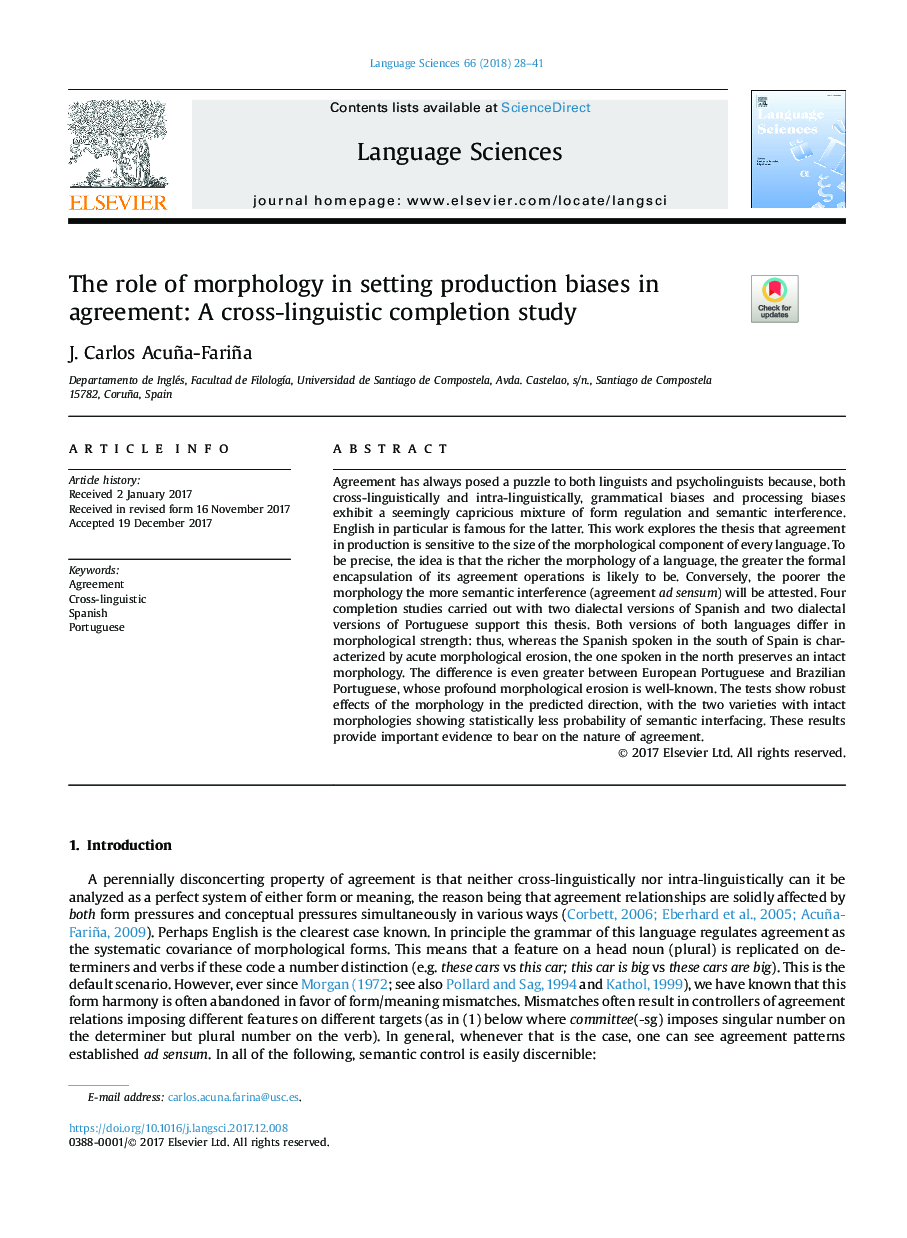| کد مقاله | کد نشریه | سال انتشار | مقاله انگلیسی | نسخه تمام متن |
|---|---|---|---|---|
| 7533810 | 1488137 | 2018 | 14 صفحه PDF | دانلود رایگان |
عنوان انگلیسی مقاله ISI
The role of morphology in setting production biases in agreement: A cross-linguistic completion study
ترجمه فارسی عنوان
نقش مورفولوژی در تنظیم تعصبات تولید در توافق: مطالعه تکمیل متقابل زبانی
دانلود مقاله + سفارش ترجمه
دانلود مقاله ISI انگلیسی
رایگان برای ایرانیان
کلمات کلیدی
توافق، متقابل زبان، اسپانیایی، پرتغالی،
ترجمه چکیده
توافقنامه همیشه به معنی زبان شناسان و روان شناسان شناخته شده است، زیرا هر دو متقابل زبان و درون زبانی، تعصبات گرامری و تعصبات پردازش، ترکیبی ظاهرا فریبنده از تنظیم فرم و دخالت معنایی را نشان می دهد. انگلیسی به ویژه برای دومین بار مشهور است. این کار به بررسی این نکته می پردازد که توافق در تولید حساس به اندازه مولفه های مورفولوژیکی هر زبان است. به طور دقیق، این ایده این است که مورفولوژی زبان هر چه غنی تر باشد، هرچه اندازه گیری رسمی عملیات توافقنامه خود، احتمالا بیشتر باشد. برعکس، مورفولوژی فقیرتر، تداخل معنایی بیشتر (توافق آگاهانه) تایید می شود. چهار تکمیل مطالعات انجام شده با دو نسخه گویش اسپانیایی و دو نسخه گویش پرتغالی این پایان نامه را پشتیبانی می کند. هر دو نسخه از هر دو زبان در قدرت مورفولوژیکی متفاوت هستند: بنابراین، در حالی که اسپانیایی که در جنوب اسپانیا صحبت می شود با فرسایش مورفولوژیکی حاد شناخته شده است، کسی که در شمال صحبت می شود، مورفولوژی نامحدود را حفظ می کند. تفاوت بین پرتقال اروپایی پرتغالی و برزیل حتی بیشتر است، که فرسایش مورفولوژی عمیق آن بسیار شناخته شده است. این آزمایش ها اثرات مؤثری از مورفولوژی را در جهت پیش بینی شده نشان می دهد، با دو نوع مورفولوژی نامحدود نشان می دهد که احتمال آماری کمتر از رابطۀ معنایی وجود دارد. این نتایج شواهد مهمی را در مورد ماهیت توافق ارائه می کنند.
موضوعات مرتبط
علوم انسانی و اجتماعی
علوم انسانی و هنر
زبان و زبان شناسی
چکیده انگلیسی
Agreement has always posed a puzzle to both linguists and psycholinguists because, both cross-linguistically and intra-linguistically, grammatical biases and processing biases exhibit a seemingly capricious mixture of form regulation and semantic interference. English in particular is famous for the latter. This work explores the thesis that agreement in production is sensitive to the size of the morphological component of every language. To be precise, the idea is that the richer the morphology of a language, the greater the formal encapsulation of its agreement operations is likely to be. Conversely, the poorer the morphology the more semantic interference (agreement ad sensum) will be attested. Four completion studies carried out with two dialectal versions of Spanish and two dialectal versions of Portuguese support this thesis. Both versions of both languages differ in morphological strength: thus, whereas the Spanish spoken in the south of Spain is characterized by acute morphological erosion, the one spoken in the north preserves an intact morphology. The difference is even greater between European Portuguese and Brazilian Portuguese, whose profound morphological erosion is well-known. The tests show robust effects of the morphology in the predicted direction, with the two varieties with intact morphologies showing statistically less probability of semantic interfacing. These results provide important evidence to bear on the nature of agreement.
ناشر
Database: Elsevier - ScienceDirect (ساینس دایرکت)
Journal: Language Sciences - Volume 66, March 2018, Pages 28-41
Journal: Language Sciences - Volume 66, March 2018, Pages 28-41
نویسندگان
J. Carlos Acuña-Fariña,
